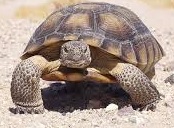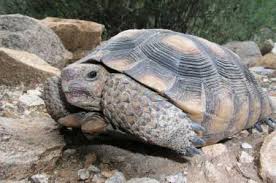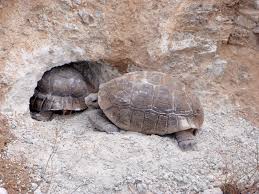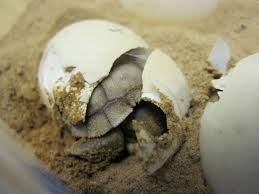
Desert tortoise
(Gopherus agassizii)

The desert tortoises are two species of tortoise native to the Mojave and Sonoran Deserts of the southwestern United States and northwestern Mexico and the Sinaloan thornscrub of northwestern Mexico. G. agassizii is distributed in western Arizona, southeastern California, southern Nevada, and southwestern Utah. The specific name agassizii is in honor of Swiss-American zoologist Jean Louis Rodolphe Agassiz. Recently, on the basis of DNA, geographic, and behavioral differences between desert tortoises east and west of the Colorado River, it was decided that two species of desert tortoises exist: the Agassiz's desert tortoise (Gopherus agassizii) and Morafka's desert tortoise (Gopherus morafkai). G. morafkai occurs east of the Colorado River in Arizona, as well as in the states of Sonora and Sinaloa, Mexico. This species may be a composite of two species.
The new species name is in honor of the late Professor David Joseph Morafka of California State University, Dominguez Hills, in recognition of his many contributions to the study and conservation of Gopherus.
The desert tortoises live about 50 to 80 years; they grow slowly and generally have low reproductive rates. They spend most of their time in burrows, rock shelters, and pallets to regulate body temperature and reduce water loss. They are most active after seasonal rains and are inactive during most of the year. This inactivity helps reduce water loss during hot periods, whereas winter hibernation facilitates survival during freezing temperatures and low food availability. Desert tortoises can tolerate water, salt, and energy imbalances on a daily basis, which increases their lifespans.
Conservation status
Vulnerable
Scientific classification |
|
| Kingdom: | Animalia |
| Phylum: | Chordata |
| Class: | Sauropsida |
| Order: | Testudines |
| Family: | Testudinidae |
| Genus: | Gopherus |
| Specie: | Gopherus agassizzii |
Description

These tortoises may attain a length of 10 to 14 in (25 to 36 cm), with males being slightly larger than females. A male tortoise has a longer gular horn than a female, his plastron (lower shell) is concave compared to a female tortoise. Males have larger tails than females do. Their shells are high-domed, and greenish-tan to dark brown in color. Desert tortoises can grow to 4-6 in (10-15 cm) in height. They can range in weight from .02 to 5 kg (0.044 to 11.023 lb). The front limbs have sharp, claw-like scales and are flattened for digging. Back legs are skinnier and very long.
Habitat

Desert tortoises can live in areas with ground temperatures exceeding 140 °F (60 °C) because of their ability to dig underground burrows and escape the heat. At least 95% of their lives are spent in burrows. There, they are also protected from freezing winter weather while dormant, from November through February or March. Within their burrows, these tortoises create a subterranean environment that can be beneficial to other reptiles, mammals, birds, and invertebrates.
Scientists have divided the desert tortoise into two types: Agassiz's and Morafka's desert tortoises, with a possible third type in northern Sinaloan and southern Sonora, Mexico. An isolated population of Agassiz's desert tortoise occurs in the Black Mountains of northwestern Arizona. They live in a different type of habitat, from sandy flats to rocky foothills. They have a strong proclivity in the Mojave Desert for alluvial fans, washes, and canyons where more suitable soils for den construction might be found. They range from near sea level to around 3,500 feet (1,100 m) in elevation. Tortoises show very strong site fidelity, and have well-established home ranges where they know where their food, water, and mineral resources are.
Desert tortoises inhabit elevations from below mean sea level in Death Valley to 5,300 feet (1,615 m) in Arizona, though they are most common from around 1,000 to 3,500 feet (300-1,070 m). Estimates of densities vary from less than eight individuals/km2 on sites in southern California to over 500 individuals/km2 in the western Mojave Desert, although most estimates are less than 150 individuals/km2. The home range generally consists of 10 to 100 acres (4-40 ha). In general, males have larger home ranges than females, and home range size increases with increasing resources and rainfall.
Desert tortoises are sensitive to the soil type, owing to their reliance on burrows for shelter, reduction of water loss, and regulation of body temperature. The soil should crumble easily during digging and be firm enough to resist collapse. Desert tortoises prefer sandy loam soils with varying amounts of gravel and clay, and tend to avoid sands or soils with low water-holding capacity, excess salts, or low resistance to flooding. They may consume soil to maintain adequate calcium levels, so may prefer sites with higher calcium content.
Reproduction

Tortoises mate in the spring and autumn. Male desert tortoises grow two large white glands around the chin area, called chin glands, that signify mating season. A male circles around female, biting her shell in the process. He then climbs upon the female and insert his penis (a white organ, usually only seen upon careful inspection during mating, as it is hidden inside the male and can only be coaxed out with sexual implication) into the vagina of a female, which is located around the tail. The male may make grunting noises once atop a female, and may move his front legs up and down in a constant motion, as if playing a drum.
Months later, the female lays a clutch of four to eight hard-shelled eggs, which have the size and shape of ping-pong balls, usually in June or July. The eggs hatch in August or September. Wild female tortoises produce up to three clutches a year depending on the climate. Their eggs incubate from 90 to 135 days; some eggs may overwinter and hatch the following spring. In a laboratory experiment, temperature influenced hatching rates and hatchling gender. Incubation temperatures from 81 to 88 °F (27-31 °C) resulted in hatching rates exceeding 83%, while incubation at 77 °F (25 °C) resulted in a 53% hatching rate. Incubation temperatures less than 88 °F (31 °C) resulted in all-male clutches. Average incubation time decreased from 124.7 days at 77 °F to 78.2 days at 88 °F (31 °C).
Diet
The desert tortoise is an herbivore. Grasses form the bulk of its diet, but it also eats herbs, annual wildflowers, and new growth of cacti, as well as their fruit and flowers. Rocks and soil are also ingested, perhaps as a means of maintaining intestinal digestive bacteria as a source of supplementary calcium or other minerals. As with birds, stones may also function as gastroliths, enabling more efficient digestion of plant material in the stomach.Much of the tortoise’s water intake comes from moisture in the grasses and wildflowers they consume in the spring. A large urinary bladder can store over 40% of the tortoise's body weight in water, urea, uric acid, and nitrogenous wastes. During very dry times, they may give off waste as a white paste rather than a watery urine. During periods of adequate rainfall, they drink copiously from any pools they find, and eliminate solid urates. The tortoises can increase their body weight by up to 40% after copious drinking. Adult tortoises can survive a year or more without access to water. During the summer and dry seasons, they rely on the water contained within cactus fruits and mesquite grass. To maintain sufficient water, they reabsorb water in their bladders, and move to humid underground burrows in the morning to prevent water loss by evaporation.
Emptying the bladder is one of the defense mechanisms of this tortoise. This can leave the tortoise in a very vulnerable condition in dry areas, and it should not be alarmed, handled, or picked up in the wild unless in imminent danger. If it must be handled, and its bladder is emptied, then water should be provided to restore the fluid in its body.
Zoológico de Vallarta A. C.
Leave your comments, your opinion is important to us

